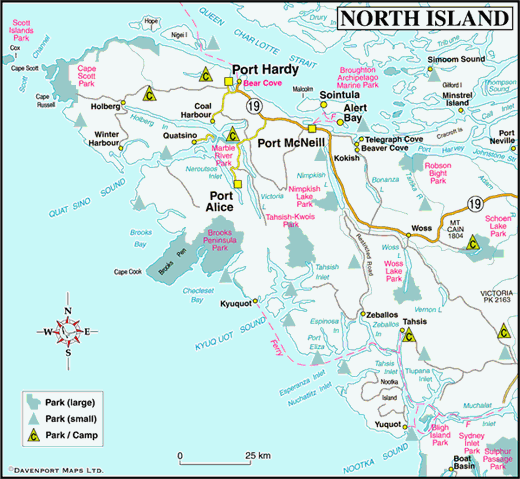The Tlatlasikwala, Nakumgilisala and Yutlinuk native peoples shared the Cape Scott area prior to white settlement. The Yutlinuk of the Scott Islands died out in the early 1800s. The Nakumgilisala and Tlatlasikwala amalgamated in the mid 1850s and moved to Hope Island where they remained until 1954. That year, numbering only 32, they joined with the Koskimo people and moved to Quatsino Sound. Today they are known collectively as the Nahwitti. They have six reserves, two of which are within the boundaries of Cape Scott Provincial Park.
From 1897 to 1907 the first white settlement attempt was made at Cape Scott. The settlers were Danes, mostly from Minnesota, Iowa, Nebraska and North Dakota looking to establish an ethnic community around Hansen Lagoon and Fisherman Bay. The colony hoped to subsist initially on fishing until the government followed through on its agreement to build a road from Fisherman Bay to San Josef River and onto Holberg. The road would provide the link necessary to get the beef and dairy products the settlers were to produce to market. Unfortunately the road never materialized.
The colony struggled to survive by fishing and trapping mink, river otter and beaver for their pelts. Eventually trapping petered out and the men were forced to leave to fish at Rivers Inlet, or to work in mines or logging camps. By 1907, the settlers had acknowledged the failure of their colony and plans were made for departure.
The population of the area between Cape Scott and Holberg numbered less than 60 in 1909. By 1913, another wave of settlers had arrived from Washington State, the prairie provinces, Eastern Canada and Europe to occupy land available for pre-emption. Many of these settlers established themselves in homes vacated by the Danes near Hansen Lagoon. Others took up land and built homes at Fisherman Bay and San Josef Bay.
The population of the second settlement peaked at over 1,000 in 1913. Thereafter it declined as the residents once again encountered the same hardships the Danes had experienced before them. Conscription in 1917 for service in the First World War brought an end to the community for a second time, and soon it was virtually deserted.
Requirements of national security during World War ll led to the construction of a small radar station at Cape Scott in 1942, which remained in operation until 1945.


